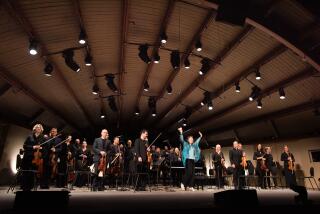MUSIC REVIEW : Mozart Camerata Performs Namesake Composer’s Pieces
- Share via
NEWPORT BEACH — The Mozart Camerata acted a bit like a builtfor-speed automobile Saturday night at St. Andrew’s Presbyterian Church: anxious to be on the open highway of an allegro movement or a bracing presto, but evincing somewhat less affinity for the stop-and-go city-driving of an andante or an adagio.
In a program devoted exclusively to works of its namesake composer--excerpts from “Don Giovanni” and “La Clemenza di Tito,” and the Symphony No. 38 in D, the “Prague”--the Camerata, under the baton of music director Ami Porat, enjoyed the assistance of guest mezzo-soprano Kimball Wheeler. It also prominently featured one accomplished member from its own ranks, clarinetist Emily Bernstein.
The “Don Giovanni” overture proved a limp warm-up. Conductor and players were unable to locate the rhythmic pulse of the awfully slow opening andante, which suffered from ragged attacks and other ensemble problems and nearly ground to a halt just as the allegro section broke forth to the rescue. Instantly the energy level rose to match the task at hand. (Whatever the performance quality, the overture loses a great deal with the abrupt “concert ending” appended to it for non-operatic occasions.)
Wheeler, billed as a “dramatic mezzo,” disclosed a medium-size lyric voice and a need to follow the score intently in “Vedrai, carino” from “Don Giovanni” (the lengthy orchestral postlude of which is a definite egg-on-face situation in concert circumstances) and “Non piu di fiori” from “Tito.”
In a second “Tito” aria, “Parto, parto,” she displayed a firmer line and more solid tone. Although the difficult fioritura at aria’s end was rough-hewn and featured some awkward breaths, Wheeler had a real go at both extremes of the two-octave range Mozart demands of his singer, ably seconded by Bernstein in the mezzo/clarinet dialogue.
Porat’s “Prague” gave proper weight to the previews of Beethoven without shortchanging the element of Mozartean grace. Though the tendency to lose rhythmic tension in the slow movements surfaced periodically, in conjunction with thin string tone in exposed sostenuto passages, at full throttle the Camerata played with style, assurance and accuracy, ultimately achieving a forthright, mellifluous reading. The orchestra demonstrated obvious affection for its leader during final bows.
More to Read
The biggest entertainment stories
Get our big stories about Hollywood, film, television, music, arts, culture and more right in your inbox as soon as they publish.
You may occasionally receive promotional content from the Los Angeles Times.










